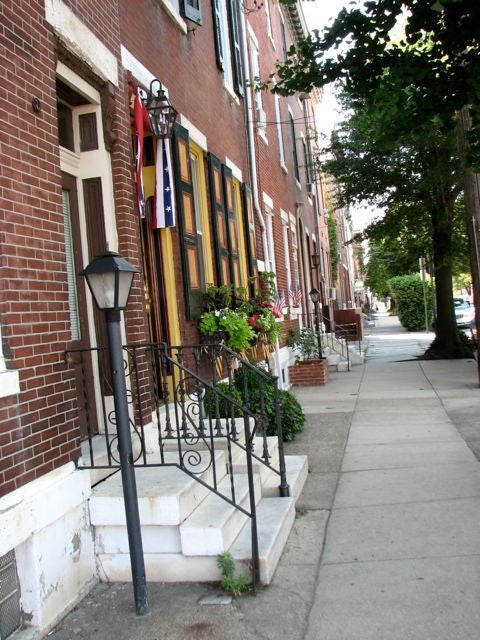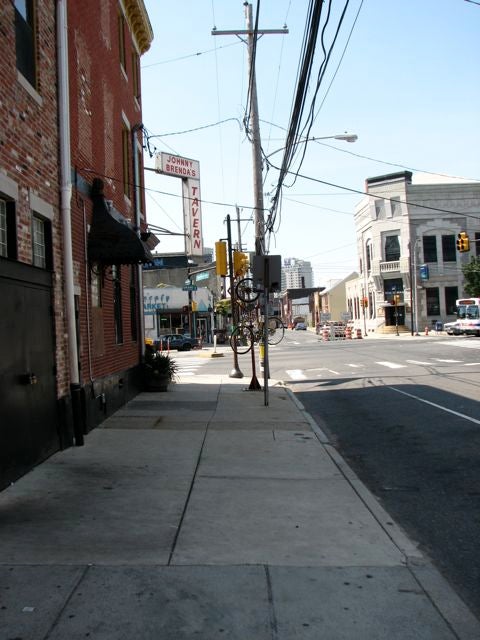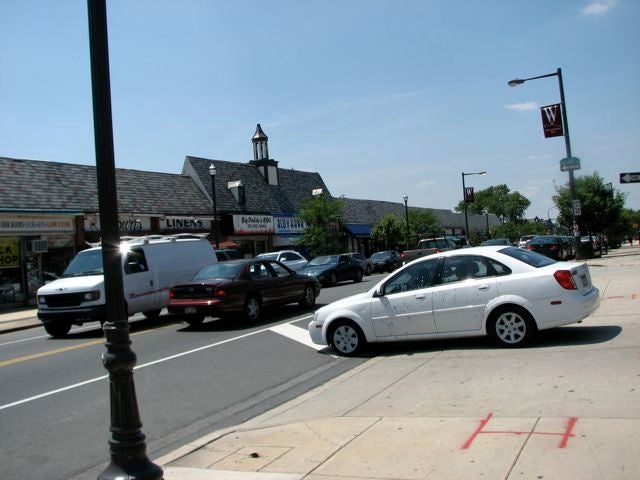New effort to strengthen Philadelphia’s neighborhood backbone
By Alan Jaffe
For PlanPhilly
Somewhere between high-flying communities like Society Hill or Chestnut Hill and the faltering sections of West or North Philly, there are stable but fragile neighborhoods that just need a little strategic help to keep them healthy.
The city has taken several approaches in recent years to maintain these areas that are referred to as the “backbone” of Philadelphia, geographically and economically.
The task of leading one of these efforts has now been passed to the Preservation Alliance of Greater Philadelphia, which this year adopted the “Vital Neighborhoods” program. Leaning on the physical and social assets that already exist in the three initial neighborhoods – Fairmount, Fishtown and East Mount Airy – the Alliance plans to build on their strong foundations and expand the program quickly to other areas of Philadelphia.
“There is a lot of attention given to creating affordable housing in the tougher neighborhoods. But those neighborhoods that fall in-between are neglected; everyone assumes they will be OK. But at the same time, it’s clear they’re not quite OK,” said John Gallery, executive director of the Preservation Alliance. “For us, this is a totally new direction, but one that grows out of our neighborhood preservation programs. And we’re pretty excited about it.”
Finding a new parent
Vital Neighborhoods was the baby of the nonprofit NeighborhoodsNow, which had developed market-driven programs to support the economic health of low- and moderate-income areas since 2006. NeighborhoodsNow chose the first three target communities for the Vital Neighborhoods program and began making strategic investments there.
But last year, the board of NeighborhoodsNow decided to wind down its operations and merge its programs with other organizations. The city’s Office of Housing and Community Development worked with NeighborhoodsNow in the selection of a new parent for Vital Neighborhoods. The candidates included the Philadelphia Association of Community Development Corporations (PACDC), the Local Initiatives Support Corporation (LISC), and the Greater Philadelphia Urban Affairs Corporation.
The Preservation Alliance was chosen to be the lead partner for the renewed effort, supported by the Center for Architecture and the Community Design Collaborative.
The Alliance had been involved in the NeighborhoodsNow advisory committee since the beginning of Vital Neighborhoods. “We always had an interest as to whether or not the neighborhoods we had an interest in – those with distinctive physical character – overlapped with the type of neighborhoods they had an interest in,” Gallery explained. “We wondered, could their program and the resources they had put together provide us with additional resources to help the neighborhoods we were working with?”
Those resources were close to $600,000 when NeighborhoodsNow decided to pass the torch. “The reason everyone was interested in this was that it was actually an opportunity that came with resources that you could do something with. This was a significant amount of seed money that would allow some expansion for a couple of years, while you tried to figure out how you would raise more money,” Gallery said.
Of the candidates interested in taking on Vital Neighborhoods, the Alliance was the only one with an active Neighborhood Preservation program already in place. Its program lends support to a wide range of communities that are not established historic districts but have buildings with distinctive architectural or historic character. Through conferences that bring the community leaders together for advice and mutual consultation, and popular Old House Fairs and workshops that teach affordable preservation methods, residents are made aware of the significance of their properties. “And it’s really the residential housing stock that is important” in these neighborhoods, Gallery said. “Whether it becomes a historic district or is listed on the Philadelphia Register is not an issue. It’s how do we get the people to really understand what’s the right way to maintain and rehab them.”
Defined by strengths and stress
In a report commissioned by NeighborhoodsNow, Protecting Philadelphia’s Backbone: A Strategy for Vital Neighborhoods, Paul C. Brophy and Thomas Burns defined the characteristics of Philadelphia’s “middle-market” neighborhoods.
They have an estimated population of 429,000, or nearly a third of the city’s total. They are 65.9 percent owner-occupied. The median residential sales price is $127,500. And they accounted for a third of all residential foreclosure filings in 2008-09.
Their primary assets that affect the strength of neighborhoods, Brophy and Burns wrote, are geography or access to transportation; the quality of the housing stock; nearby shopping options; parks and recreational amenities; schools, church and other institutions; and their safety or sense of “neighborliness.”
“Theses backbone neighborhoods to which we refer are home to many of the city’s working families – mostly blue- and white-collar workers – who own their own homes,” the report continues. “These areas are affordable and desirable for first-time home-buyers who choose to remain in the city rather than move to the suburbs. They also have the potential to attract suburban homebuyers back to the city Perhaps most critically, the residents of these neighborhoods pay a substantial portion of the city’s wage and property taxes.”
But many of the neighborhoods also show signs of “increasing stress,” according to the report, including rising foreclosure rates and outstanding tax liens. The percentage of senior citizens on fixed incomes is increasing, and those residents may not be able to maintain their properties.
“Over time, these trends undermine resident confidence in the neighborhood housing market, and make these neighborhoods less attractive to new homebuyers.”
Other models
Vital Neighborhoods is based on similar programs in other parts of the U.S. In Richmond, Va., the program is called Neighborhoods in Bloom; in Chattanooga, Tenn., the Neighborhood Preservation Program; and in Baltimore, Healthy Neighborhoods.
“These cities understand that strengthening these neighborhoods is fundamental to the future health of the entire city,” write Brophy and Burns.
“Most importantly, the actions of Baltimore, Richmond and Chattanooga demonstrate that it is legitimate public purpose to improve these areas, and that the housing policy for these neighborhoods is an essential component to a more traditional affordable housing strategy to help people get into good homes. These programs strive to stabilize and increase home values, recognizing that increases in home values build equity and wealth for the residents who live there,” Brophy and Burns report.
The Baltimore program grew in increments. It began with eight neighborhoods, grew to 15 over the next couple of years, and has reached 30 areas since it began 10 years ago
Gallery visited Baltimore two years ago to see that city’s approach. “I realized a lot of the neighborhoods where they’d been successful were areas that had all these good market conditions, but also had a very distinctive housing stock. You could have said they were historic districts. They weren’t, but they had that kind of physical character.”
Brophy and Burns found that the programs in the other cities shared a set of principles:
The cities built on the assets of the neighborhoods rather than trying to fix major problems. They helped establish and strengthen neighborhood identities, focusing on history and encouraging activities like walking tours and community newsletters. They lifted up neighborhood ambassadors who could speak about the neighborhood and attract new residents.
The cities also helped people of all income levels invest in their properties by coordinating a group of lenders to provide home improvement loans and mortgages at below-market prices. They marketed the neighborhood to those with similar income levels. And they addressed safety issues and tackled crime aggressively.
They also cleaned up vacant homes, abandoned cars and littered lots. They helped residents become directly involved in improving their blocks through small, inexpensive programs, including greening, better lighting and other beautification efforts. They built community spirit through festivals and other events. And they took a comprehensive approach to how different pieces of a neighborhood fit together and reinforce each other.
Grant tiers
The program in Baltimore was also successful, Gallery said, because it offered two alternative funding opportunities for neighborhoods that competed for help. He is thinking of using a similar structure in Philadelphia, in which the Preservation Alliance would provide ten to 15 grants of $5,000 for relatively small projects and a few grants of about $25,000 for more ambitious proposals.
“That would allow you to expand quickly. You could say, this year we are going to give 10 grants of $5,000, and here’s the criteria you can use the money for. For the $25,000 grants, you’re looking for a lot more planning and better-organized communities. It means you have to make fewer grants because you’re being more selective,” he explained.
“The smaller grants would allow a lot more neighborhoods to say there’s something we would like to do to enhance the housing market in our neighborhood. Then they could position themselves for a bigger project. That’s our thinking: how do you give people an opportunity that might lead to something larger?”
At its Neighborhood Preservation Conference held last year, the Alliance presented two $1,000 grants and two larger awards for projects that included a historic scavenger hunt in Kensington and another that promoted the use of old church buildings along Baltimore Avenue for other public purposes.
“There are a lot of people in these neighborhoods with interesting ideas, and these are ways to get people thinking about their historic resources. … We’re trying to be very open for these smaller grants and create as many opportunities as we can.”
The Vital Neighborhoods program “does fit well with the type of engagement with these organizations that we’ve been trying to have,” Gallery said. “It just broadens the perspective for us and increases the resources that we can bring to these efforts.”
Contact the reporter at ajaffe@planphilly.com
WHYY is your source for fact-based, in-depth journalism and information. As a nonprofit organization, we rely on financial support from readers like you. Please give today.







